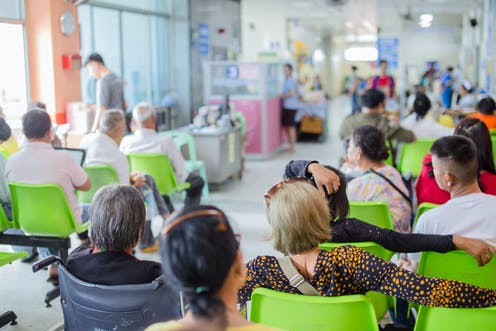
People who attend accident and emergency (A&E) departments in the UK are supposed to be admitted, transferred or discharged within four hours. But these targets haven’t been hit in England since 2015. In October of this year, A&E departments in England only achieved the four hour standard for 74% of patients. In Wales, the situation was even worse, with the four hour target only being achieved for around 65% of patients.
There are many reasons why this is the case – including increased demand due to an ageing population, struggling primary and community care services causing people to rely on A&E when it might not be clinically necessary, and lower capacity due to under-staffing and inadequate bed space for patients. The pandemic has only further increased pressure on A&E departments.
The four hour A&E target was first introduced in 2004 with the aim of reducing waiting times and helping to combat overcrowding. However, the creation of the target itself wasn’t based on evidence or expert opinion.
There are some misconceptions about the target – for instance, some may believe that it means a person should wait no more than four hours before being seen by a clinician. What the target actually means is that within four hours of arrival at A&E, a patient should be seen, treated and discharged, or admitted to a ward. This time might include multiple interactions with clinicians, waits for diagnostic tests and doctors or nurses checking in with other areas of the hospital.
There are a many reasons why the target might be missed – such as if a patient needs more investigation for a certain condition, or because of overstretched services outside of the emergency department. Other delays might be due to a lack of community support, especially if a patient needs ongoing care after they leave, which might not be available. For example, an elderly patient who attends A&E due to a fall might need a home safety assessment or a care plan in place to ensure it’s safe for them to go home. While this is an issue outside the remit of the emergency department, it could still be reflected in the four hour target.
Pros vs cons
For many years, there’s been discussion of the target’s relevance and whether or not it should be scrapped.
Proponents of the four hour target argue that it’s associated with fewer deaths and that it might be used to improve staffing levels – by arguing that if a department is missing its target, it needs more resources.
But critics of the target point out there’s no evidence-based reason why four hours is the specified time. They also emphasise that it tells us very little about the patient’s care – for instance, why they didn’t receive care during the four hours.

antoniodiaz/ Shutterstock
The targets have also been linked to staff stress and a shift in focus from quality of care to timeliness. In other words, meeting the target might pressure staff into making decisions that prioritise meeting the target, as opposed to what’s best for the patient. Research also suggests the four hour target has not resulted in consistent improvements in patient care – with high variability between hospitals. Improvements aren’t always clearly linked to the target itself either.
Ultimately, the Royal College of Emergency Medicine acknowledges these drawbacks, but recommends keeping the target as they believe it incentivises timely care for patients. But many patients don’t mind waiting, as long as they’re triaged promptly and told how long they might have to wait for treatment – and why.
The future of A&E
Given many A&E departments still fall short despite the four hour target, there’s a clear need for better measures. But instead of focusing on overall length of stay, future measures might shine a light on the stages at which patients are experiencing delays. There are some signs that this is happening, but such new measures will only work if the data collected from them is actually used to continue making improvements to benefit patients.
In December 2020, NHS England published plans to transform the way A&E performance is measured. The recommendations include measuring the percentage of ambulance handovers within 15 minutes, the time to initial assessment, and the average time spent in the department.
In Wales, three new measures were introduced in 2020 which are reported upon monthly. These include how long a patient waits to be triaged, how long until they see a decision-making clinician, and what the outcome was – such as if they were referred to a GP or outpatient service.
These measures were developed through collaboration with people working in emergency departments in Wales and are underpinned by clinical guidelines, which recommend patients are seen within 15 minutes of arrival to ensure high risk patients are identified early so they can receive critical treatments. It’s also recommended that patients are seen by a clinician as early as possible after triage. It’s hoped these measures will help drive improvement.
The pandemic has had an undeniable impact on emergency care. But it has also highlighted the pressures emergency departments were already under and asked us to reconsider how to ensure patients are receiving the best care possible. The plans recently introduced in England and Wales, which emphasise stages of emergency care over a single time target, may be a step in the right direction.
![]()
Katie Jones holds an honorary contract with The National Collaborative Commissioning Unit, hosted by Cwm Taf University Health Board.
j.y.rance@swansea.ac.uk receives funding from the National Collaborative Commissioning Unit, hosted by Cwm Taf University Health Board.
























